Designing Skateboard Graphics: The Art of Functionality
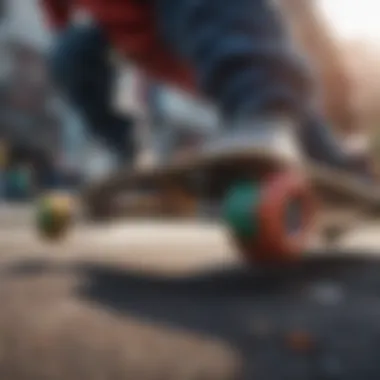
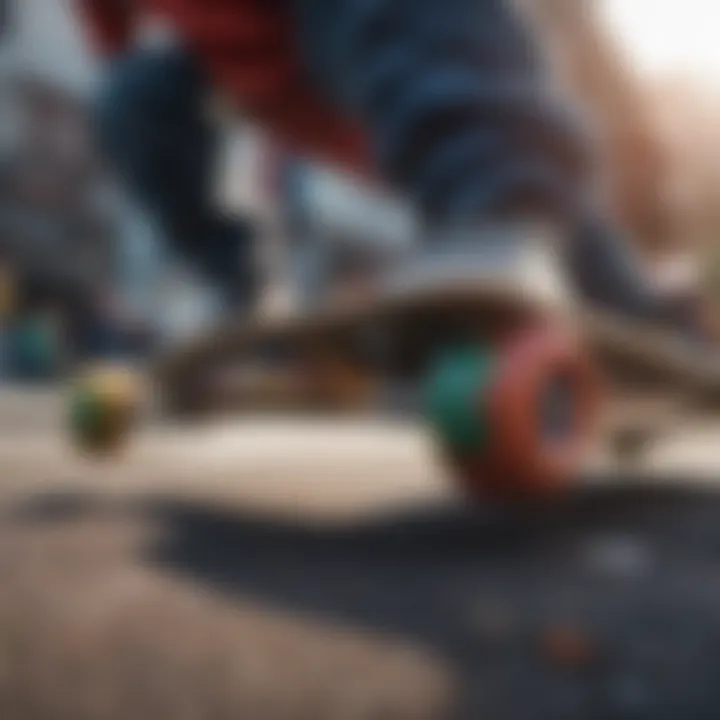
Intro
Skateboarding is more than just a sport; it is a vibrant culture that thrives on artistic expression. At the core of skateboarding lies the skateboard itself, and its graphic design plays a crucial role. The graphic serves not only as a representation of personal style but also carries historical significance within the skate community. As styles evolve, so do the techniques and elements that define skateboard graphics. This article delves into the intricate process of designing these graphics, exploring the intersection of art and functionality.
Techniques and Tips
Creating skateboard graphics involves a combination of creativity and technical skill. Understanding the process can empower both aspiring artists and longtime enthusiasts.
Skill Development
To excel in skateboard graphic design, developing your skills is essential. Start by practicing drawing and digital illustration. Programs like Adobe Illustrator and Photoshop are widely used in this field. Familiarity with these tools will help bring your ideas to life.
Practical Techniques
Crafting an effective skateboard graphic requires several key considerations:
- Understanding space: The skateboard's shape influences the design. Curves and angles must complement, not hinder, graphic visibility.
- Color Theory: Colors evoke emotions. Choosing the right palette can enhance the appeal and resonance of your design.
- Typography: If text is included, it should be clear and legible. Experiment with fonts that reflect the skateboard's style and the intended message.
These techniques will help ensure your graphic stands out while remaining functional.
Common Mistakes to Avoid
Embarking on the graphic design journey can be daunting. Here are common pitfalls to steer clear of:
- Neglecting to research existing styles can lead to uninspired work.
- Overcomplicating designs may confuse viewers; simplicity often holds more impact.
- Ignoring community feedback can prevent growth. Engaging with fellow designers or audiences can provide valuable insights and improvements.
Gear and Equipment
The right tools can make a significant difference in the quality of your skateboard graphics.
Essential Gear for Beginners
Starting with basic tools will ease your entry into graphic design:
- Sketchbooks and pencils for initial concepts.
- A sturdy scanner to digitize hand-drawn images.
- A reliable computer with design software, such as Adobe Illustrator.
Latest Innovations and Trends
Today, technology significantly influences graphic design in skateboarding. Digital printing techniques allow for high-quality replication and custom designs at scale. The rise of online marketplaces enables artists to reach broader audiences than ever.
Reviews and Comparisons
Evaluating various design software is beneficial. Options like CorelDRAW and Affinity Designer come with their own unique features. Familiarizing yourself with these can help determine which aligns best with your workflow.
Safety Measures
While designing graphics is one facet, safety in skateboarding remains paramount.
Essential Safety Gear
To enjoy skateboarding safely, investing in protective gear is crucial:
- Helmets: Must fit properly to protect the skull and brain.
- Wrist Guards: Crucial for preventing injuries during falls.
- Knee and Elbow Pads: Essential to minimize painful scrapes and bruises.
Best Practices for Safe Participation
Riding skills also require attention. Learn how to fall safely and practice in controlled environments. Passion for the sport must also include a commitment to personal safety. Engaging with experienced riders can provide useful tips on improving your technique.
Injury Prevention and Management
Understanding common injuries helps in prevention. Ankle sprains and wrist injuries are frequent. Strengthening these areas with exercises can make a difference. Always observe your limits to avoid worsening injuries during practice.
Spotlights on Extreme Sports
Highlighting exceptional figures in the skating community is vital. Not every rider becomes a star, but those who do often inspire countless others.
Featured Sport of the Month
Each month brings new events and competitions globally. Keeping an eye on these can reveal burgeoning talents and trends in the sport.
Profiles of Prominent Athletes


Learning about influential skateboarders can provide insight into their techniques and designs. Athletes like Tony Hawk and Nyjah Huston often collaborate with designers to create unique graphics that resonate within skate culture. Their stories and styles work together to inspire the next generation.
Graphic design in skateboarding is about merging personal expression with functional artistry.
Preamble to Skateboard Graphics
Skateboard graphics combine artistic flair with practical needs in a unique way. This section delves into how these graphics serve various purposes. For example, they not only beautify the board but also tell a story. Designs often reflect the identity of the rider or the culture of skateboarding as a whole.
The creation of these graphics goes beyond aesthetics. They can impact the way skaters perceive their boards. The relationship between a skater and their board is deeply personal. Consequently, the graphics can become a significant aspect of this bond.
Historical Context
Skateboard graphics have a rich history, tracing their roots back to the early days of skateboarding in the 1970s. During this period, skaters began to personalize their boards. They used stickers and spray paint to express their individuality. The rise of well-known skateboard brands like Powell Peralta introduced iconic graphics that defined a generation of skaters. These designs often featured bold imagery, from cartoon-like characters to intricate tribal patterns.
Over time, artists such as Jim Phillips and Ed Templeton emerged, bringing a new level of artistry to skateboard graphics. Their works laid foundations for modern designs. This historical context highlights how skateboard graphics evolved as an integral part of skate culture, merging creativity with personal expression and brand identity.
Importance in Skate Culture
The significance of skateboard graphics in skate culture cannot be overstated. These visuals do more than decorate a board; they serve as a medium for statement and representation. Graphical designs often carry messages of rebellion, freedom, or a unique outlook on life. They contribute to the visual language that defines skateboarding communities.
Moreover, these graphics can elevate a brand's status in a competitive market. When a brand has strong, recognizable graphics, it cultivates a loyal following. Skaters want to be associated with the lifestyle that their board represents. Thus, the importance of carefully designed graphics extends into marketing realms as well.
In summary, understanding skateboard graphics is crucial. It reveals the intersection of art and culture. This connection is essential for anyone interested in the world of skateboarding.
Understanding Graphic Design Principles
Graphic design forms the backbone of skateboard aesthetics. Understanding graphic design principles is essential for effective creation of skateboard graphics. This knowledge allows designers to balance artistic and functional aspects effectively. It involves recognizing how graphics influence the perception of the skateboard and appeal to skaters who often identify with the artwork on their boards.
Elements of Design
Design incorporates fundamental elements that each contribute to visual effectiveness. The primary elements include line, shape, color, texture, and space. Each of these components plays a crucial role in how a skateboard graphic is perceived:
- Line: This element guides the viewer's eye. It can create motion or stability depending on its direction and weight.
- Shape: This defines the structure of the design. It can evoke certain feelings or reflect themes relevant to skate culture.
- Color: This evokes emotions and sets the mood of the graphic. Different colors can attract various groups within the skate community.
- Texture: Adding texture can bring depth, making the design more appealing and engaging.
- Space: This refers to the area around and between the elements. Effective use of space can enhance focus on key aspects of the design.
Mastering these elements leads to the development of compelling skateboard graphics that resonate with the target audience.
Color Theory
Color theory is another vital aspect of graphic design. Understanding how colors interact can greatly impact the effectiveness of skateboard graphics. Colors can express emotions or ideas, making their choice critical when designing unit.
- Color Wheel: It shows how colors relate to each other. Complementary and analogous colors are especially useful in grabbing attention.
- Psychology of Color: Different colors can symbolize various emotions. For instance, red can evoke excitement, while blue can convey calmness.
- Cultural Associations: Some colors hold specific meanings in different cultures. Designers should consider these associations to resonate with a global audience.
Utilizing color theory effectively helps in creating designs that stand out and capture attention.
Typography in Skateboard Graphics
Typography plays a significant role in skateboard graphics. The choice of typeface can communicate messages clearly while enhancing the overall aesthetic. Key considerations include:
- Font Selection: Different styles evoke different feelings. A bold font may convey strength, while cursive can give a more artistic feel.
- Readability: The text must be legible even at a distance. Skaters often ride fast, making it essential that graphics, including typography, can be appreciated quickly.
- Integration with Design: Typography must complement, not overpower, the other elements. It should harmonize with graphics and colors used within the overall design.
Incorporating these principles leads to skateboard graphics that not only attract but also communicate effectively, engaging the thrill-seekers and extreme sports enthusiasts in their graphic representation.
Techniques for Designing Skateboard Graphics
The creation of skateboard graphics cannot be overstated in its importance within both the art and skateboarding realms. This section will explore various techniques that designers employ to achieve eye-catching, functional, and meaningful designs. These techniques not only enhance the aesthetic appeal but also serve as a key aspect of branding and personal expression for both the skateboarders and the designers themselves.
Illustration Techniques
Illustration techniques form the backbone of skateboard graphics. Designers often rely on hand-drawn illustrations, which can provide a unique, authentic feel to the boards. Various styles, from intricate line work to bold, simplified shapes, can define the character of a design. Furthermore, illustrators often explore themes that resonate within the skate community, incorporating elements related to skate culture. For example, urban landscapes, animals, or abstract forms might dominate illustrations.
The choice of technique can influence how potential buyers perceive a brand. A vibrant, quirky illustration might attract a younger audience, while a more subdued, artistic representation might appeal to seasoned skaters. Hence, understanding the target audience is critical in the illustration phase.
- Key Considerations:
- Style: Match your illustration style with the brand's identity.
- Relevance: Ensure designs resonate with the target audience.
- Technique Proficiency: Develop skills in diverse illustration methods to maintain flexibility in design.
Digital Design Tools
In today’s digital age, various tools are available for creating skateboard graphics. Software like Adobe Illustrator, CorelDRAW, and Procreate allow designers to create high-resolution, print-ready designs efficiently. These tools provide functionalities such as layers, which help in managing complex designs with ease. Unlike traditional methods, digital tools enable faster revisions and scalable designs that can be utilized across different platforms, from merchandise to online promotion.
Moreover, the integration of 3D design software can offer a new dimension to the graphics. Designers can visualize how their artworks will appear on a skateboard before finalizing. This precision leads to better outcomes and aids in aligning the design with the skateboard's shape and size.
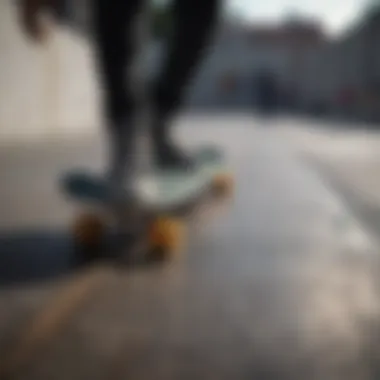
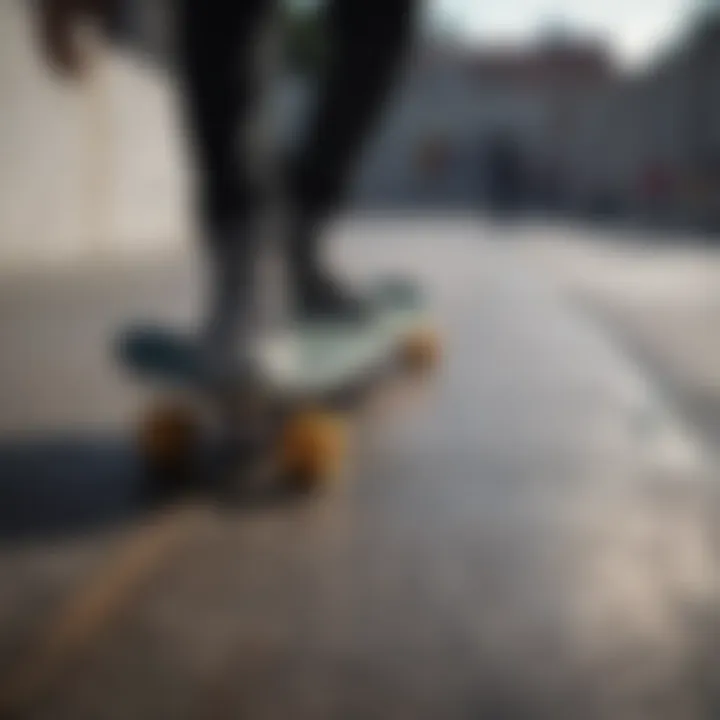
- Benefits of Digital Tools:
- Efficiency: Speed up the design process with real-time editing.
- Collaboration: Facilitates sharing and feedback among team members.
- Versatility: Easily adapt designs for different formats and materials.
Screen Printing Process
The screen printing process remains one of the most popular and effective methods for applying graphics onto skateboards. This technique involves transferring ink through a mesh screen onto the board's surface. Each color in the design requires a separate screen, which can be labor-intensive but results in vibrant, durable prints.
Screen printing is valued for its ability to create rich textures and lasting colors that can withstand the wear and tear associated with skateboarding. A well-executed screen print will showcase both depth and complexity, enhancing the overall aesthetic of the board. It is beneficial to collaborate closely with printers to ensure that the final product aligns with the designer’s vision.
"Screen printing is not just a technique; it’s an art form that transforms ideas into tangible expressions on skateboard decks."
- Considerations for Screen Printing:
- Quality of Materials: Always use high-quality inks and boards for the best durability.
- Print Placement: Pay close attention to where the design is positioned on the board.
- Testing: Perform test prints to address potential issues before the final run.
In summary, the techniques involved in designing skateboard graphics are multifaceted. Illustration techniques cater to creativity, digital design tools offer efficiency, and the screen printing process ensures quality. Each aspect plays a crucial role in the final product, making it essential for designers to master these techniques.
Branding and Marketing in Skateboard Graphics
Branding and marketing play a crucial role in the skateboard industry. These elements are not just about selling products but also about creating a lifestyle that resonates with riders. The visuals on a skateboard are a profound part of its identity, reflecting the brand's values and the community's spirit. It is essential to convey the right message through the artwork. This helps establish loyalty and connection with consumers, which is vital in a competitive market.
Creating a Visual Identity
Creating a visual identity involves more than just selecting colors and logos. It is about crafting an image that represents the brand's ethos. This identity should be consistent across all platforms, from product designs to social media presence.
Key components to consider include:
- Logo Design: A memorable logo can enhance brand recognition. This icon often becomes synonymous with the brand itself.
- Color Palette: Colors evoke emotions. Therefore, a well-thought-out color scheme can attract the target audience and convey the right atmosphere.
- Typography Style: The choice of fonts contributes to the overall feel of the brand. It should reflect the vibe of skate culture, be it edgy, playful, or classic.
In many ways, the visual identity sets the stage for how a brand is perceived within the skate community.
Target Audience Considerations
Understanding the target audience is fundamental. Skateboard graphics must resonate with specific demographics. Skaters range from young children to adults, each with distinct preferences. Market research helps identify these groups, leading to informed design choices.
Considerations include:
- Age: Younger skaters may prefer vibrant designs, while older riders might lean towards minimalistic styles.
- Cultural Influences: Skaters often draw inspiration from various subcultures, such as punk or hip-hop. Graphics should reflect these influences to engage effectively.
- Local Trends: Regional preferences can significantly impact design. Collaborating with local artists can enhance authenticity and community connection.
Tailoring designs to the audience enhances emotional engagement and brand loyalty.
Collaboration with Skaters
Collaborating with skaters in the design process is invaluable. These individuals provide insights into what resonates with them and their peers. Such engagement ensures that the graphics capture the lived experiences and aspirations of skaters.
Benefits of collaboration include:
- Authenticity: Having skaters involved lends credibility to the designs. It shows that the brand values the voice of its community.
- Feedback Loop: Skaters can provide constructive feedback on designs before they go into production, allowing for adjustments that align with their expectations.
- Ambassadorship: When skaters feel a personal connection to the graphics, they are more likely to promote the brand organically through their riding and social media.
In summary, branding and marketing in skateboard graphics are vital to navigating the industry's competitive landscape. A strong visual identity, a clear understanding of the target audience, and collaboration with skaters pave the way for creating graphics that not only sell but also build lasting relationships within the skate community.
The Evolution of Skateboard Graphics
The evolution of skateboard graphics is a compelling narrative that highlights the growth and transformation of both the sport and art form. Understanding this evolution is crucial as it sheds light on how skateboarding transcended its original context to become a powerful medium for self-expression and cultural commentary. In this section, we will explore the significant milestones and trends that have shaped skateboard graphics, underscoring how they’ve evolved over the decades to reflect broader societal changes.
Trends Over the Decades
Skateboard graphic trends have undergone numerous transformations since the sport's inception in the 1960s. Each decade has contributed unique styles and philosophies to the table.
- 1960s: The early graphics were simple and often hand-painted. The designs reflected the free-spirited nature of the surfers turned skateboarders.
- 1970s: As skateboarding gained popularity, more intricate designs emerged. Artists began to employ bold colors and fluid shapes resembling pop art. Influences from surf culture were still prevalent.
- 1980s: This decade marked a significant shift with the introduction of skulls, flames, and other edgy elements. The emergence of companies like Powell Peralta revolutionized graphics with iconic characters and narratives. These graphics appealed to the rebellious spirit of youth.
- 1990s: Skateboard graphics embraced grunge influences, with darker themes and influences from underground art. This period saw artists like Ed Templeton translate their gritty vision onto skateboard decks.
- 2000s and Beyond: Modern graphics often blend digital design with traditional art forms, reflecting technological advances. Minimalism became popular alongside complex, vibrant designs. This diversity reflects the multitude of subcultures within skateboarding itself.
Influence of Street Art
The influence of street art on skateboard graphics is undeniable. Street artists like Banksy and Shepard Fairey have brought significant visibility to the urban art scene, and this has spilled over into the skateboard world. The relationship between street art and skateboarding is symbiotic:
- Visibility: Skateboards are portable canvases. Street art's themes of rebellion and commentary on societal issues resonate strongly within skate culture. Artists can bring their work to life on a medium that moves through public spaces, thereby reaching a broader audience.
- Collaboration: Many skateboard brands now collaborate with street artists, providing them a platform to showcase their art. This benefits both the artists and the brands, enriching the overall visual landscape of skateboarding.
- Cultural Intersection: Street art allows for rapid reflection of current events and cultural shifts on skateboard graphics. This timely artistic response keeps the designs relevant and engaging.
Impact of Technology
Technology has profoundly influenced skateboard design. This impact encompasses not only the creation of graphics but also their production and distribution:
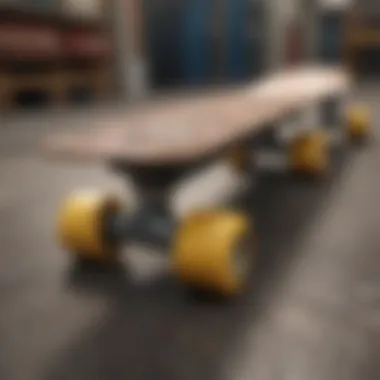
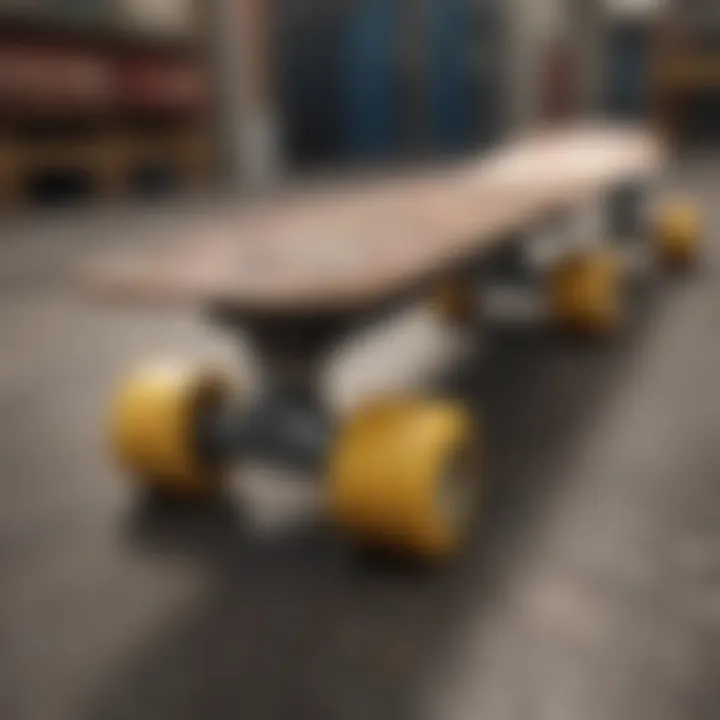
- Digital Design Tools: The availability of software like Adobe Illustrator and Procreate allows designers to experiment with styles and collaborate seamlessly. Artists can manipulate designs with precision and ease, creating everything from intricate patterns to bold graphic statements.
- Screen Printing Advances: Innovations in screen printing technology have improved the quality and durability of skateboard graphics. Now, designs can be more elaborate and long-lasting, enhancing the rider's experience.
- Online Platforms: The rise of social media and e-commerce has expanded the reach for skateboard artists. They can directly market their designs to skateboarding communities around the globe, enabling a wider appreciation for unique artistic expressions.
"The evolution of skateboard graphics illustrates not just a change in design, but also a shifting cultural landscape that continually reinvents itself."
Current Trends in Skateboard Graphics
In the fast-paced realm of skateboarding, staying updated with current trends is essential. These trends reflect not only the artistic inclinations of designers but also the evolving identity of the skateboarding community. Understanding contemporary graphics informs producers, skaters, and enthusiasts about what resonates with the community. From aesthetic fluctuations to ethical considerations, these trends shape the market and its direction in design and culture.
Minimalism vs. Maximalism
The debate between minimalism and maximalism dominates modern skateboard graphic design. Minimalism favors clean lines and subdued colors, emphasizing simplicity and elegance. This approach often highlights the form of the skateboard itself, allowing the artistry to speak subtly. Brands like Anti-Hero exhibit this trend with understated designs.
In contrast, maximalism embraces bold colors, intricate patterns, and complex illustrations. It reflects an exuberant aesthetic, capturing the energy of skate culture. Skateboards from companies like Element often display maximalist tendencies, filled with vibrant graphics that demand attention. These contrasting styles cater to different tastes among riders, influencing their choices and personal expressions.
Environmental Considerations
As awareness of ecological issues grows, the skateboard industry responds by integrating environmental considerations into design. Designers are exploring sustainable materials and eco-friendly printing techniques. This trend is more than a marketing strategy; it signifies a commitment to reducing the industry's carbon footprint. Brands such as Plan B have taken steps toward sustainability, using recycled materials and non-toxic inks in their boards.
Additionally, graphics reflecting eco-conscious themes appeal to an audience increasingly united by ecological activism. Designs that embrace nature or highlight environmental issues foster a connection between the skater and the planet, promoting a positive image for brands while also inspiring consumers to be mindful of their impact.
Inclusivity in Design
Inclusivity emerges as a crucial trend, reflecting a broader cultural shift. Skateboarding has historically been a male-dominated space, but contemporary designs actively embrace diversity. Graphics now celebrate a variety of cultures, genders, and identities. This change expands the skateboarding community, encouraging and welcoming new participants from different backgrounds.
Designers and brands are collaborating with skaters from various demographics to create graphics that resonate with underrepresented voices. Recognizable designers like Cleo McGloin prioritize inclusivity, ensuring that a broader audience sees themselves represented in skateboard graphics. This trend not only enhances social cohesion but also enriches the creative landscape, enabling innovation and fresh perspectives.
"Today's skate graphics are not just about aesthetics—they amplify the voices and stories of a diverse community."
In summary, the current trends in skateboard graphics represent evolving artistic expressions and societal values. Whether through minimalism, maximalism, environmental consciousness, or inclusivity, each trend reveals a layer of complexity within the skateboarding world and its culture.
Rider Experience and Graphic Interaction
Rider experience is central to understanding the interaction between skateboard graphics and those who use them. It is not merely about aesthetics; it is about how these designs enhance the connection between the rider and the board. Each graphic carries significance, providing identity and affirming the rider's place within the skate culture. When skaters choose a board, they often look for one that resonates with their personal style and preferences. This makes graphics a vital part of the selection process.
The relationship between the rider and their skateboard is deeply emotional and psychological. When a skater identifies with the graphic on their board, it often boosts their confidence and performance. The visuals can evoke feelings of empowerment or nostalgia, which can directly influence how a rider performs. This psychology is critical because it emphasizes that graphics are not just surface-level; they can impact the rider's mindset.
Psychological Impact of Graphics
Each skateboard graphic can captivate the rider and provoke a thought process. Studies show that colors, shapes, and imagery can trigger specific emotions. For instance, vibrant colors may evoke enthusiasm, while darker shades could represent intensity or passion.
- Color Psychology:
- Warm Colors: Often associated with energy and excitement.
- Cool Colors: Typically engender calmness and stability.
Moreover, unique design elements can resonate with prevailing themes in skate culture. For example, grunge-style graphics may appeal to skaters with street influences. This resonance helps to reinforce community ties within skateboarding.
"The right graphic can elevate a visual experience, fostering not just personal expression but collective identity."
Personalization of Boards
The trend of personalizing skateboard graphics is growing among riders. Customization allows individuals to express their uniqueness. Riders can go beyond standard designs, adding their flair and making their boards truly theirs.
- Methods of Personalization:
- Hand-painted designs.
- Stickers that reflect personal interests.
- Graphic alterations using digital tools.
This personal touch transforms each board into a canvas for the rider's narrative, enhancing their bond with it. Personalized graphics often tell stories or convey messages, whether they be about personal experiences or broader cultural movements.
Culmination: The Future of Skateboard Graphics
The future of skateboard graphics looks promising as it continues to evolve alongside the changing skate culture. Graphic design is a core element in the identity of skateboarding. The integration of art and functionality will keep pushing creative boundaries and comprehensive designs. As skaters seek both aesthetic appeal and personal expression, designers must adapt to these dynamic demands.
Emerging Designers to Watch
New talent is always surfacing in the skateboard graphic scene. Designers with fresh ideas tend to challenge conventional norms. They create innovative designs that introduce new perspectives on style, culture, and the skateboard experience. Notable emerging designers include artists who leverage social media to showcase their work, effectively reaching a wider audience.
Keep an eye on platforms like Instagram and Behance, where you can discover young talents capable of setting future trends in the skateboard community. Engaging with these designers is a way to appreciate the diverse expressions of art within the sport.
Innovative Technologies in Design Production
Advancements in technology play a crucial role in the evolution of skateboard graphics. The use of software such as Adobe Illustrator and Procreate enables designers to create intricate and detailed designs with relative ease. Furthermore, new printing technologies, such as direct-to-film printing, are revolutionizing how graphics are produced on skateboard decks.
There are also opportunities to utilize eco-friendly materials in producing skateboard graphics. Brands increasingly focus on sustainability in response to environmental concerns. Innovations in inks and materials are helping to reduce the ecological footprint of skateboard production. This shift reflects an evolving consumer consciousness, where skaters not only care about aesthetics but also about the impact of their choices.
The intersection of art and technology will continue to shape the future of skateboard graphics, offering endless possibilities for creativity and sustainability.
In summary, the future of skateboard graphics remains bright and full of potential. Emerging designers bring new ideas that challenge the norm while technology enhances the design and production processes. These developments will likely lead to unprecedented creativity and expression in the skateboarding culture.







